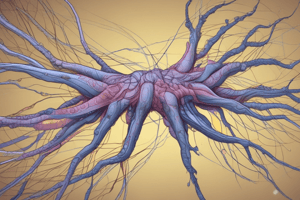Podcast
Questions and Answers
What is the primary function of the Peripheral Nervous System (PNS) in terms of impulses and chemical traffic?
What is the primary function of the Peripheral Nervous System (PNS) in terms of impulses and chemical traffic?
- It receives impulses from the brain and sends them to the Central Nervous System (CNS)
- It conducts impulses and chemical traffic (correct)
- It processes and integrates information from the CNS and PNS
- It regulates the body's response to stress and emotion
What is the effect of neural mobilization on neural axon transport?
What is the effect of neural mobilization on neural axon transport?
- It has no effect on neural axon transport
- It improves neural axon transport (correct)
- It decreases neural axon transport
- It reverses neural axon transport
What is the consequence of inflammation of nerves in the nervous system?
What is the consequence of inflammation of nerves in the nervous system?
- It results in the formation of scar tissue and increased nerve conduction
- It leads to demyelination and increased nerve excitability
- It causes intra-neural fibrosis and decrease of nerve excitability (correct)
- It has no effect on nerve function
What is the indication for neural mobilization in terms of vertebral region injuries?
What is the indication for neural mobilization in terms of vertebral region injuries?
What is the definition of neural mobilization?
What is the definition of neural mobilization?
What is the consequence of spondylosis on neural mobilization?
What is the consequence of spondylosis on neural mobilization?
What is the effect of neural mobilization on intra-neural edema?
What is the effect of neural mobilization on intra-neural edema?
What is the relationship between neural mobilization and body movement?
What is the relationship between neural mobilization and body movement?
What is the consequence of demyelination on nerve function?
What is the consequence of demyelination on nerve function?
What is the effect of neural mobilization on blood flow?
What is the effect of neural mobilization on blood flow?
Study Notes
Types of Connective Tissues in Nervous System
- Meninges are a type of connective tissue in the nervous system
- Axon myelin Schwann cells are another type of connective tissue in the nervous system
Physiology of Nervous System
- The Central Nervous System (CNS) sends impulses to the Peripheral Nervous System (PNS)
- Connective tissues (CT) are continuously connected around all body organs in different shapes
- Neurons receive impulses from the brain
- Humans have a high ability to perform skilled movements due to the connection with the nervous system
- The nervous system not only receives and sends impulses but also has the ability to adapt to various movements and ranges
Mechanics of Peripheral Nervous System
- The Peripheral Nervous System (PNS) conducts impulses and chemical traffic
- PNS is a dynamic tissue
- PNS can be extremely elongated
- PNS functions by stretching and sliding as a result of a wide variety of movements
Spinal Canal Variation
- The spinal canal varies in size and shape according to the vertebral level and movement
- C1 vertebra occupies half of the canal, while C5 occupies ¾ of the canal
- T6 has a narrower and more rounded canal, making it more prone to injury
- The spine elongates in flexion more than in extension
- In side bending, the bended side is shortened, and the other side is elongated
- Changes also occur in spine rotation
Pathophysiology of Nervous System
- Direct injury can occur due to tension, overstretching, or compression
- Indirect injuries can occur due to extra neural injuries, such as soft tissue or fibro-osseous injuries
- Intra-neural injuries can occur due to inflammation of nerves, leading to changes in connective tissue and decreased nerve excitability
- Causes of intra-neural injuries include demyelination, hypoxia, scar tissue, and neuroma
Neural Mobilization
- Neural mobilization is a manipulative technique that moves and stretches neural tissues by moving relative or surrounding structures
- Effects of neural mobilization include improving neural axon transport, reducing intra-neural edema, increasing blood flow, and restoring normal mechanisms of connective tissue
Indications and Contraindications of Neural Mobilization
- Indications for neural mobilization include any neurological symptoms, unexplained loss of strength, vertebral region injuries, and musculoskeletal injuries
- Precautions for neural mobilization include spinal stenosis, spondylosis, involvement of other structures, neurological signs, dizziness, general health, and circulatory disorders
- Contraindications for neural mobilization include acute inflammation and infection, acute neurological signs, worsening of neurological signs, cauda equina, malignant tumors, and injuries to the spinal cord
Neuro Dynamic Tests
- Findings on neuro dynamic tests can be classified as optimal, suboptimal, normal, or abnormal
Relation between Nervous System and Body Movement
- Neural tissue mobilization requires the body part to be moved with other parts in a neutral position to decrease tension in tissues and move the neutral part
Studying That Suits You
Use AI to generate personalized quizzes and flashcards to suit your learning preferences.
Description
Explore the physiology of the nervous system, including the types of connective tissues and the mechanics of the peripheral nervous system. Test your knowledge of how the nervous system functions and adapts to various movements and ranges.




